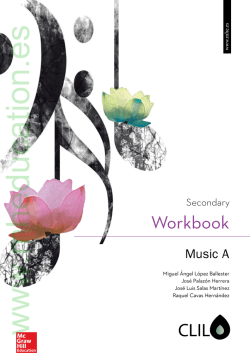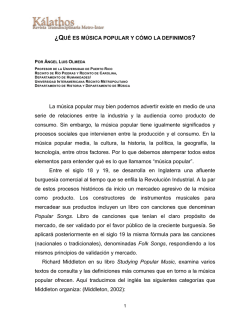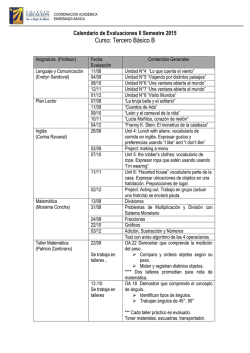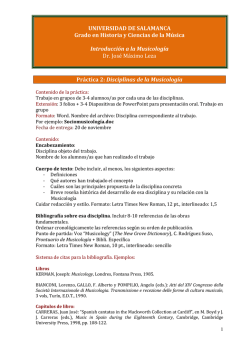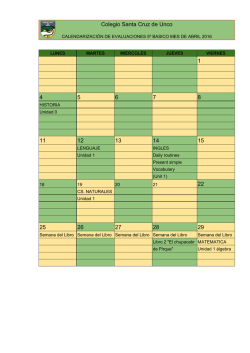
1 - McGraw-Hill Education
www.mheducation.es www.mheducation.es MUSIC B SECONDARY José Palazón Herrera Miguel Ángel López Ballester Pedagogical Advisor Inmaculada Martínez Riazuelo Workbook MADRID · BUENOS AIRES · CARACAS · GUATEMALA · MEXICO NEW YORK · PANAMÁ · SAN JUAN · BOGOTÁ · SÃO PAULO AUCKLAND · HAMBURG · LONDON · MILAN · MONTREAL · NEW DELHI · PARIS SAN FRANCISCO · SYDNEY · SINGAPORE · SAINT LOUIS · TOKYO · TORONTO www.mheducation.es CONTENTS UNIT 1 Chords and lutes 5 Mind map Unit activities Final activities Let’s write music Let’s read music Extension exercises Musical games Recording fact file Melody exercises / Rhythm exercises 5 6 9 12 12 13 14 15 16 Mind map Unit activities Final activities Let’s write music Let’s read music Extension exercises Musical games Recording fact file Melody exercises / Rhythm exercises 17 18 21 24 24 25 26 27 28 UNIT 2 Pentatonic airs 17 UNIT 3 Colours and contrasts 29 Mind map Unit activities Final activities Let’s write music Let’s read music Extension exercises Musical games Recording fact file Melody exercises / Rhythm exercises UNIT 4 Tonality and balance 39 Mind map Unit activities Final activities Let’s write music Let’s read music Extension exercises Musical games Recording fact file Melody exercises / Rhythm exercises UNIT 5 Travelling music 29 30 31 34 34 35 36 37 38 39 40 42 46 46 47 48 49 50 51 Mind map Unit activities Final activities Let’s write music Let’s read music Extension exercises Musical games Recording fact file Melody exercises / Rhythm exercises 51 52 53 56 56 57 58 59 60 www.mheducation.es CONTENTS UNIT 6 Character and innovation UNIT 7 Music in cinema, radio and television UNIT 8 Music and new technologies 61 Mind map Unit activities Final activities Let’s write music Let’s read music Extension exercises Musical games Recording fact file Melody exercises / Rhythm exercises 61 62 65 68 68 69 70 71 72 Mind map Unit activities Final activities Let’s write music Let’s read music Extension exercises Musical games Recording fact file Melody exercises / Rhythm exercises 73 74 76 78 78 79 80 81 82 Mind map Unit activities Final activities Let’s write music Let’s read music Extension exercises Musical games Recording fact file Melody exercises / Rhythm exercises 83 84 85 88 88 89 90 91 92 73 83 1 www.mheducation.es CHORDS AND LUTES Characteristics R Gregorian c music Modern auditorium Performance T S Chord: a group of t Triplet: a r only t Secular Subject: love, war... Language Instruments Rhythm Sung as solos P -musical compositions in a -Portuguese G dialect de Santa M • • • • There was a lot with of v diverse shapes and names Medieval instruments Interval: the difference in p • • • • • • Characteristics Las C music Religious rhythm F In L Sung a c authors A • S • M • N Styles Musical contexts: medieval music Language and creation • • • • • S B Psaltery Medieval v between two notes or more musical n that sound s cell considered ‘irregular’ because it has three notes where usually there are Afro-Caribbean music style originating from J What is it? Reggae Bob M Representative Counterpoint: arrangement of sounds from two or more m from each other i Mode: a used in the M A l that have a certain and the Renaissance 5 www.mheducation.es unit 1 1 3 6 Unit activities This section follows the numbering of the Student's Book. You will find discontinuous numbers, since only the exercises that the student must write have been included in this Workbook, whereas those which only involve listening or performing have been left out. This remark is valid for the rest of the Units. 1.Listen to the following excerpt of a Gregorian chant and try to answer the following questions: a ) Can you hear instruments or just voices? b ) Is there one or are there several voices singing? c ) Can you recognise the language they sing in? 2.Listen to an excerpt of the song Tant ai aimé (How much I have loved) from the medieval troubadour Conon de Béthune. Write the differences you can hear in comparison with the Gregorian chant. www.mheducation.es chords and lutes Unit activities 5 4.Listen carefully to the three excerpts of the Gregorian chant on the unit resources. Copy these scores of the first two excerpts and try to place the syllables of the text with the notes in the scores. Specify which melodic style each one corresponds to. Excerpt 1. Text: Kyrie Eleison Melody style: Excerpt 2. Text: Lauda Sion salvatorem, Lauda ducem et pastorem Melody style: Excerpt 3. Text: Puer Natus est nobis et filius Melody style: 7 www.mheducation.es unit 1 10 8 Unit activities 6.Listen to the following recording. There are four excerpts with different medieval instruments. Then look at the following miniatures from the collection of cantigas of Alfonso X. Match each of the excerpts you hear with the miniatures according to the medieval instruments in them. Figure 1.5 Excerpt no.: Figure 1.6 Excerpt no.: Figure 1.7 Excerpt no.: Figure 1.8 Excerpt no.: 7.Make a) intervals (3rd, 5th and 8th) and b) perfect chords from the following sounds. For the last two, duplicate one of the notes. www.mheducation.es chords and lutes FINAL ACTIVITIES 1.Define interval and chord. Interval: Chord: 2.Name the following intervals. 3.Observe the following chords and indicate which examples are perfect chords. This means with the 3rd and 5th interval over the lower note, as you learnt earlier in this unit. a ) b ) c ) d ) e ) f ) 4.Explain what a quaver triplet is. Write two 4/4 bars that contain at least two triplets. 9 www.mheducation.es unit 1 10 FINAL ACTIVITIES 5.Look on the internet for Arab music and list its characteristics. 6.Research the website of the Monasterio de Santo Domingo de Silos (Silos Abbey) (http://www.abadiadesilos.es/) and answer the following questions: a ) Which Spanish province is the monastery in? b ) How many CDs have the monks published? c ) What time of day do the monks sing their prayers? d ) Look for the score of the hymn Veni Creator Spiritus (Come Creator Spirit) and decide which melodic style it uses: syllabic, melismatic or neumatic. 7.True or false? a ) Music from the Middle Ages is exclusively religious. b ) Gregorian chants are sung in Latin, have a free rhythm, are monodic and are sung a cappella. c ) There were well-known composers of Gregorian chants. d ) The troubadour movement started in Germany. e ) The troubadour and minstrel songs are accompanied by instruments, they talk about love and war and are sung in modern languages. f ) King Alfonso X el Sabio participated in the writing of some cantigas (songs). g ) We consider Las Cantigas de Santa María a genre of secular music. www.mheducation.es chords and lutes FINAL ACTIVITIES 8.How are your detective skills? In the Middle Ages, there was a monk called Guido d’Arezzo. He is attributed with first naming the musical notes through the use of a religious hymn to Saint John the Baptist. a ) Read it and find the hidden notes: ut queant laxis resonare fibris mira gestorum famuli tuorum sol ve populi labii reatum Sancte Iohanes b ) If you have found the hidden notes, which one is completely different from the ones you know? 9.Which ideological movement is associated with Reggae music? Name some of the most representative musicians of this music. 10.Match the musical characteristics with the musical styles. Chords and off-beats with the guitar • • Troubadours Monodic, free rhythm and a cappella • • Reggae Monodic, accompanied with instruments • • Gregorian chants Alternating verses and chorus in Galician-Portuguese dialect • • Cantiga 11 www.mheducation.es unit 1 Let’s write music This section is intended for writing music reproducing the examples provided in the most faithful way possible, i.e. like a handwriting exercise, so you must take extra care to write correctly. 1.Draw the following chords on the stave below. Under each chord, state its name. C 2.Draw the following arpeggios on the stave below. Let’s read music 3.Read the names of the notes in this melody, which is built on an ancient scale, the Dorian scale. Take care to read the notes with their correct duration. 12 www.mheducation.es chords and lutes Extension exercises 4.Let's review what has been learnt throughout this Unit. Fill in the gaps with the appropriate words. a ) We call the distance between two sounds . When three or more different sounds occur simultaneously, this is called . The artificial split of a crotchet into three quavers is called . b ) Among the instruments of Arab music, we can name the Arab , the flute and, in the case of percussion, the . c ) Gregorian chants are chants made for and its texture is . The lyrics of Gregorian chants are written in and are characterised by having a rhythm that is . d ) The Cantigas de Santa María narrated the of the Virgin Mary and the language that they are written in is . Thanks to its collection of around two thousand we have a lot of information about the instruments of the time. e ) Reggae music was born in and its main representative artist is . 5.Review of intervals. Based on the note given, build the required interval. Example: Asc. harm. 4th Asc. mel. 5th Asc. harm. 6th Desc. mel. 7th Asc. harm. 8th Desc. mel. 4th Asc. harm. 3rd 6.Chords: In each case, draw the notes that are missing to complete the chord. 13 www.mheducation.es unit 1 Musical games 7.Read the definitions and write the names in the spaces of the crossword. 14 Vertically 2. Name of a very common texture in Arab music. 3. Religious chant in Latin, sung a cappella, which has a free rhythm. Horizontally 1. Three or more different sounds that occur simultaneously. 4. Poetic-musical compositions in Galician-Portuguese. 5. String instrument from the Middle Ages. 6. Afro-Caribbean musical style born in Jamaica. 7. Melody style of Gregorian chants that assigns many notes to a single syllable. 2 7 1 4 3 6 5 www.mheducation.es chords and lutes Recording fact file Recording no. Piece/song: Author: Time period: Style: Performer: Genre: Noteworthy musical aspects: Recording no. Piece/song: Author: Time period: Style: Performer: Genre: Noteworthy musical aspects: 15 www.mheducation.es unit 1 Melody exercises Rhythm exercises 16 www.mheducation.es McGraw-Hill Education Telf. Servicios al educador 902 289 888 / [email protected] www.mheducation.es www.mheducation.es Publicaciones personalizadas a tu medida ¡Elige el contenido y crea el manual que mejor se adapta a tus necesidades! Create permite crear una obra personalizad a través de un proceso fácil e intuitivo seleccionando material del catálogo de McGraw-Hill. Además, se puede adaptar a las necesidades de cada docente ¡añadiendo material propio! El deseo de todos los profesores ha sido siempre tener el libro que refleje fielmente los temas del curso y con el que los alumnos dispongan de todo el material que necesitan para seguir la clase y superar la asignatura. McGraw-Hill Education fiel a su misión de ayudar a los docentes y enseñar a los estudiantes, pone a disposición de cualquier profesor su oferta editorial y la diversidad de las soluciones de aprendizaje de las que dispone para lograr este objetivo. Entra en nuestra web: http://create.mheducation.com ¡Accede a todo el catálogo! y crea tu libro a medida en 3 sencillos pasos www.mheducation.es Una nueva forma de leer... Una nueva forma de aprender ¿Te imaginas un libro de texto adaptado a las necesidades individuales de cada estudiante? Porque el aprendizaje lo cambia todo IO PREMO SIM ACIÓN EDUC 2015 el ador d ® , gan n al Book Smart IMO Educació S Premio ITAL SO DIG IAL ECUR R R O R IT O N ED MEJ EACIÓ ías DE CR nolog ad Tec d li a la d u o a . en la m sos para el r u c e yr SmartBook® es la primera y única experiencia de lectura y aprendizaje adaptativo diseñada para cambiar la forma en la que los estudiantes leen y aprenden, rompiendo con el camino lineal de los libros de texto tradicionales y adaptándose a las necesidades y al ritmo de cada estudiante. www.mheducation.es SmartBook® ¿Qué es? SmartBook® es una herramienta de aprendizaje adaptativo que combina una revolucionaria tecnología desarrollada por McGraw-Hill Education con un libro digital interactivo. SmartBook® analiza la forma en la que lee y aprende el estudiante y, en función de sus respuestas a preguntas sobre lo estudiado y la seguridad sobre sus conocimientos, le va guiando a través de los contenidos del libro, de una manera personalizada y adaptada a su propio ritmo de aprendizaje, para que cada minuto que pasa el alumno estudiando sea lo más efectivo posible. ¿Cómo funciona? SmartBook® consta de varias fases: Lee En la fase de lectura, el estudiante es guiado a través del texto para que lea de una manera adaptada a sus necesidades. En SmartBook® el estudiante tiene acceso al texto completo, pero se le mostrarán áreas resaltadas en amarillo que indican el contenido en el que debería centrar su estudio en ese momento concreto. Las áreas resaltadas del texto van variando en función de sus respuestas en la parte práctica, subrayando nuevos temas y conceptos de más nivel, una vez que el estudiante ha demostrado el dominio de los conceptos esenciales del tema. 2 www.mheducation.es Practica En la fase de práctica, los estudiantes afianzan lo aprendido hasta el momento realizando una serie de actividades de diversa tipología. Antes de responder, se pedirá al estudiante que evalúe el grado de seguridad sobre sus conocimientos: Sé la respuesta Eso creo No estoy seguro Ni idea En función de las respuestas a esas preguntas, el grado de seguridad que establezcan y otros datos que va recogiendo el sistema mientras los estudiantes trabajan, SmartBook® irá ajustando el camino de aprendizaje de cada estudiante adaptándolo a su ritmo y necesidades y determinando cuál será la siguiente pregunta. Lee Practica De vuelta en la fase Lee, el estudiante se encontrará con nuevas partes del texto resaltadas en amarillo, que indican el nuevo contenido a estudiar, y otras resaltadas en verde, que son los temas o conceptos que el estudiante ha demostrado que domina al responder correctamente a las preguntas en la fase de práctica. Subrayado amarillo: muestra el contenido que es importante para el estudiante en este momento. Subrayado verde: muestra el contenido que el estudiante ha demostrado que domina realizando preguntas en la fase de práctica. La mejor manera de estudiar con SmartBook® es ir pasando de una fase a otra hasta completar la unidad. La propia herramienta ayudará al estudiante a identificar cuándo ha llegado el momento de cambiar de fase. Repasa Para asegurar el dominio de los temas y la retención a largo plazo de los conceptos aprendidos, en esta fase el estudiante repasa en forma de actividades el contenido importante que el sistema ha identificado que es más probable que olvide. Informes www.mheducation.es Informes completos sobre el progreso del curso Profesor Los informes del profesor le permiten conocer en tiempo real las fortalezas y las debilidades de sus alumnos de manera individual y a nivel global, y adaptar así sus clases y tutorías. Estudiante Los informes del estudiante proporcionan detalles sobre su progreso, sobre los temas que domina y los que necesita estudiar más, para que pueda maximizar su tiempo de estudio. Beneficios Todo son ventajas Para el profesor: Para el estudiante: • Mejora la calidad y la productividad de las clases. • Ofrece el contenido adecuado para cada estudiante en el • Facilita la adaptación de las clases al nivel y necesidades de los alumnos. • Ayuda a prevenir el posible fracaso escolar y a remediarlo antes de que ocurra. • Mejora el rendimiento de los alumnos y su nivel de notas. momento preciso para maximizar el tiempo de estudio. • Excelente preparación para clase y para los exámenes. • Ayuda a retener conceptos clave a largo plazo. • Ayuda a conseguir mejores notas. • Herramienta online: sin descargas, sin necesidad de grabar el progreso. • Acceso en cualquier momento a través de una conexión a Internet y desde múltiples dispositivos. • Interfaz intuitiva y atractiva. • Es divertido, porque permite competir con otros usuarios. Integra SmartBook® en tu curso www.mheducation.es La mejor manera de sacar el máximo provecho a las ventajas de SmartBook® es crear una clase a la que se apuntarán tus alumnos. Los estudiantes pueden trabajar independientemente o asociados a tu clase, pero la experiencia es mucho más positiva y productiva si se integra SmartBook® como una parte más de la asignatura. Te damos algunas opciones o ideas: ... ... antes de ir a clase Puedes decir a tus alumnos que estudien con SmartBook® antes de ir a clase. Así, podrás basar tus clases en los datos que obtengas con la herramienta. ... como deberes Puedes presentar el contenido en clase y después, a modo de deberes, decirles que estudien el tema con SmartBook®. Posteriormente, en función de los datos que obtengas sobre el progreso, las fortalezas y las debilidades de tus alumnos, podrás reforzar ciertos contenidos y hacer un seguimiento general e individual de lo que realmente se ha aprendido. ... antes del examen Puedes dar la unidad completa y recomendar a tus alumnos que utilicen SmartBook® para preparar el examen. Si tienen examen de final de curso, recuerda a tus alumnos que utilicen regularmente la fase Repasa para estar preparados cuando llegue el gran día. Si tus alumnos tienen dificultades para acceder a Internet, una buena solución puede ser dedicar periódicamente tiempo de clase a SmartBook® en el aula de informática. www.mheducation.es McGraw-Hill Education una editorial global a tu servicio CICLOS FORMATIVOS FORMACIÓN PROFESIONAL CERTIFICADOS UNIVERSIDAD BACHILLERATO SECUNDARIA MEDICINA PRIMARIA PROFESIONAL Para más información: Tel. 902 289 888 [email protected] www.mheducation.es / www.mhe.es La tienda de www.mheducation.es McGraw-Hill Education te ofrece las mejores ventajas 5% de descuento Tus libros de texto con un Envío GRATIS en todo nuestro fondo editorial 20% de a partir de 25€ descuento Consigue tus Gastos de Envío GRATIS ¡Ahórrate un 20% en los libros de tus hijos cada curso! Ahora en McGraw-Hill Education te regalamos los gastos de envío. Si el importe de tu pedido es superior a 25€, los gastos de envío valorados en 5€ serán descontados de tu compra. Compra cualquiera de nuestros títulos para Primaria y ESO y disfruta de un descuento inmediato del 20% en el precio de tus libros. 5% de descuento en todo nuestro fondo editorial Todos los productos McGraw-Hill Education más económicos en nuestra tienda online. Selecciona tu producto y benefíciate de un 5% de descuento comprando cualquiera de nuestros títulos. Nuestro proceso de compra es muy sencillo 1 Localiza todos nuestros productos en el apartado TIENDA en el menú principal. 2 Encuentra tu producto navegando por nuestro catálogo o en el buscador. 3 Añade a la CESTA lo que quieres adquirir e inicia el proceso de compra, pinchando en REALIZAR PEDIDO. Regístrate como cliente y visualiza siempre que quieras el contenido de tu cesta o las compras realizadas ¡Todo el fondo de McGraw-Hill Education en papel o formato digital ahora más fácil y económico! www.mheducation.es Porque el aprendizaje lo cambia todo www.mheducation.es ¡La tienda online de McGraw-Hill Education! www.mheducation.es Toda la información | Todos los productos | Sencillo y rápido Atención al profesorado: 902 929 008 • 902 289 888 [email protected] McGraw-Hill Education Basauri, 17 - Edificio Valrealty - Planta 1ª 28023 Aravaca (Madrid) Teléfono: 91 180 30 00 • Fax: 91 180 31 00 www.mheducation.es
© Copyright 2025
